计算机辅助翻译报告二
《2024年计算机辅助翻译技术与翻译教学》范文
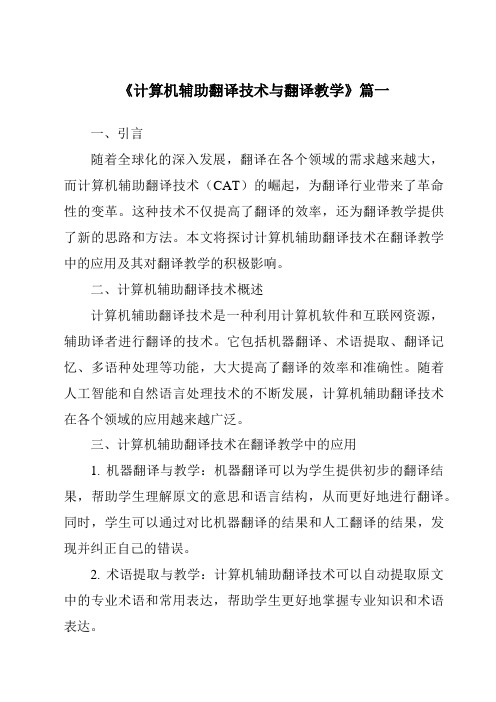
《计算机辅助翻译技术与翻译教学》篇一一、引言随着全球化的深入发展,翻译在各个领域的需求越来越大,而计算机辅助翻译技术(CAT)的崛起,为翻译行业带来了革命性的变革。
这种技术不仅提高了翻译的效率,还为翻译教学提供了新的思路和方法。
本文将探讨计算机辅助翻译技术在翻译教学中的应用及其对翻译教学的积极影响。
二、计算机辅助翻译技术概述计算机辅助翻译技术是一种利用计算机软件和互联网资源,辅助译者进行翻译的技术。
它包括机器翻译、术语提取、翻译记忆、多语种处理等功能,大大提高了翻译的效率和准确性。
随着人工智能和自然语言处理技术的不断发展,计算机辅助翻译技术在各个领域的应用越来越广泛。
三、计算机辅助翻译技术在翻译教学中的应用1. 机器翻译与教学:机器翻译可以为学生提供初步的翻译结果,帮助学生理解原文的意思和语言结构,从而更好地进行翻译。
同时,学生可以通过对比机器翻译的结果和人工翻译的结果,发现并纠正自己的错误。
2. 术语提取与教学:计算机辅助翻译技术可以自动提取原文中的专业术语和常用表达,帮助学生更好地掌握专业知识和术语表达。
3. 翻译记忆与教学:通过利用翻译记忆功能,学生可以快速查找和引用之前的翻译结果,提高翻译效率。
同时,教师可以通过分析学生的历史翻译记录,了解学生的学习进度和存在的问题,从而更好地指导学生。
四、计算机辅助翻译技术对翻译教学的积极影响1. 提高教学效率:计算机辅助翻译技术可以辅助教师进行翻译教学,减轻教师的负担,提高教学效率。
同时,学生可以利用计算机辅助翻译技术进行自主学习和练习,提高学习效果。
2. 培养综合能力:通过使用计算机辅助翻译技术,学生可以锻炼自己的语言能力、专业知识、逻辑思维等多方面的能力,为成为一名优秀的译者打下坚实的基础。
3. 适应行业需求:随着全球化的深入发展,计算机辅助翻译技术已经成为行业趋势。
通过学习和掌握计算机辅助翻译技术,学生可以更好地适应行业需求,提高自己的就业竞争力。
计算机辅助翻译报告
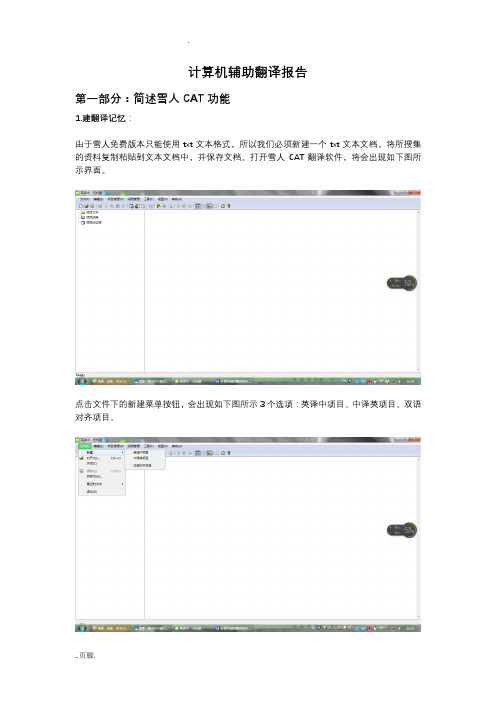
计算机辅助翻译报告第一部分:简述雪人CAT功能1.建翻译记忆:由于雪人免费版本只能使用txt文本格式,所以我们必须新建一个txt文本文档,将所搜集的资料复制粘贴到文本文档中,并保存文档。
打开雪人CAT翻译软件,将会出现如下图所示界面。
点击文件下的新建菜单按钮,会出现如下图所示3个选项:英译中项目、中译英项目、双语对齐项目。
新建一个双语对齐项目,会弹出如下窗口,页面显示项目设置、用户词典、服务器设置。
点击项目设置栏,会出现记忆库最小匹配度,如果文章内容比较专业,则相应的匹配度设置较低,如果文章内容比较平常,则相应的匹配度设置较高。
一般设置匹配度的最佳范围在0.5至0.6之间。
同时,在记忆库最小匹配度下方有6个选项:相似句子使用自动翻译、译文首字母大写、不使用系统词典、不使用规则词典、不使用在线翻译、识别大写词语。
根据所需要的要求勾选相应的选项。
点击用户词典,弹出如下图所示窗口,如果需要添加词典,可以点击添加按钮,并按确认键结束。
右击项目文件,弹出两个选项:导入文件、导出记忆库,我们现在的目的是建立翻译记忆,所以选择导入文件选项。
打开导入文件选项,出现如下图所示界面。
现在我们开始导入文本,有4种导入文本方法:第一种:我们先复制要导入的文本,直接粘贴到相应的框内,如:英文文本粘贴到英文框内,中文文本粘贴到中文框内,下图是粘贴后的文本。
框下方有4个选项:使用词典辅助对齐、识别软回车、使用段落信息、不合并句子。
根据自己的需求勾选相应选项。
最后点击确定按钮,软件自动断句,对齐结果如下图所示:如果软件自动断句句子结构内容过长或者出现原文与译文不对应的情况,如下图所示,可进行手动对齐对文本进行调整。
操作方法如:将鼠标放于需要断句的断点,按Enter键即可手动断句,相应的译文也要断句。
如下图所示:第二种:点击读入英文,把准备好的英文文档读入进来。
同理,读入中文。
最后点击确认按钮即文本导入成功。
第三种:双语粘帖。
首先复制双语,然后点击双语粘帖按钮,软件即可将双语自动分类到相应的文本框内,最后再点击确认按钮,则文本导入成功。
《2024年计算机辅助翻译技术与翻译教学》范文

《计算机辅助翻译技术与翻译教学》篇一一、引言随着全球化的加速和科技的快速发展,计算机辅助翻译技术(CAT)已经成为了翻译领域的一项重要工具。
同时,这一技术在翻译教学中也发挥着越来越重要的作用。
本文旨在深入探讨计算机辅助翻译技术与翻译教学的关系,并探讨如何利用计算机辅助翻译技术提高翻译教学质量。
二、计算机辅助翻译技术概述计算机辅助翻译技术是一种利用计算机软件和工具,辅助翻译人员进行翻译的技术。
这种技术可以大大提高翻译的效率和准确性,减少人工翻译的错误和遗漏。
计算机辅助翻译技术包括机器翻译、术语库管理、翻译记忆库等多个方面。
三、计算机辅助翻译技术在翻译教学中的应用1. 机器翻译在翻译教学中的应用:机器翻译是计算机辅助翻译技术的重要组成部分,它可以帮助学生在短时间内了解并掌握大量的翻译知识和技巧。
在翻译教学中,教师可以利用机器翻译的结果作为参考,帮助学生更好地理解原文和译文之间的关系,提高翻译的准确性和流畅性。
2. 术语库在翻译教学中的应用:术语库是计算机辅助翻译技术中另一个重要的组成部分,它可以帮助学生在短时间内掌握大量的专业术语和词汇。
在翻译教学中,教师可以利用术语库来帮助学生熟悉和掌握专业术语,提高其专业水平。
3. 翻译记忆库在翻译教学中的应用:翻译记忆库可以帮助学生保存和重复使用之前的翻译结果,从而避免重复劳动和提高工作效率。
在翻译教学中,教师可以通过教授学生如何使用翻译记忆库来提高其工作效率和准确性。
四、计算机辅助翻译技术对翻译教学的促进作用1. 提高教学效率:通过使用计算机辅助翻译技术,教师可以快速地展示大量的实例和资料,使学生更快地掌握相关的知识和技巧。
此外,教师还可以通过在线学习平台等手段进行远程教学,方便学生的学习和复习。
2. 增强教学效果:计算机辅助翻译技术可以帮助学生更好地理解和掌握原文和译文之间的关系,从而提高其翻译的准确性和流畅性。
此外,术语库和翻译记忆库等工具也可以帮助学生更快地熟悉和掌握专业术语和词汇,提高其专业水平。
计算机辅助翻译项目演示报告

使用网络语料的翻译方法 (以google为例)
• 1.google——强大的搜索引擎
• 2.使用检索语法规则
“专业领域+检索词” “检索词+文档类型” “检索词+通配符”
例:* ? “检索词A+B检索词”表示A或B “检索词A OR B检索词”表示要么有A,要么有B
• 但是,机辅翻译软件其实和办公软件一样,无论 对于翻译的辅助有多么大,都不能取代人脑的作 用。翻译软件的术语统一,文档排版,重复句段 翻译等功能和作用非常强大,但是翻译作为一种 语言交换活动,最核心的依然是语言处理工作。 所以对于软件,学习和探索是必要的,但不应该 是主要的。
The end
University
• 3、高职高专
3. Vocational and technical colleges
• 3.1厦门海洋职业技术学院 3.1 Xiamen Ocean Vocational College
章节数字翻译
一、编码 ➢ 如果原文的章节编码未使用中文数字,则原则上保
留其编码格式。
➢ 如果原文的章节编码使用了中文数字,但未使用罗 马数字,则以罗马数字取代中文数字,其余格式不 变。例:“一”译为“I”,“(一)”译为 “(I)”。
➢ 如果原文的章节编码使用了中文数字,也使用了罗 马数字,这时只能看具体情况来确定英文文件的编 码格式。
二、标题 ➢ 标题1(如“1”):加粗字形,词首字母大写,
其余小写;
➢ 标题2(如“1.1”):常规字形,词首字母大写, 其余小写;
➢ 标题3(如“1.1.1”):常规字形,标题首词的 首字母大写,其余小写;
2021日常翻译工作中计算机辅助翻译的运用范文2

2021日常翻译工作中计算机辅助翻译的运用范文 摘要: 随着计算机技术的不断发展,各种建立在计算机技术基础上的功能技术也相继研发出来,为人们对额工作和生活提供了较大的便利。
在翻译工作中,翻译人员会借助计算机辅助翻译,来实现高质量的全自动翻译。
在实践应用中,计算机辅助翻译起到了十分重要的作用,也推动了计算机技术的不断发展。
在一些高校已经开设了计算机辅助翻译课程,计算机技术是处于不断发展中的,会带动计算机辅助翻译功能的发展和实施,为翻译工作提供更加高质量的服务。
关键词: 计算机;辅助翻译; 实际应用; 计算机辅助翻译这一概念被提出时间比较早,但真正实现应用还是在计算机和互联网的崛起之后,为该项思想提供了技术支持,使得计算机辅助翻译开始实现跨越式发展,大量的计算机辅助,翻译软件涌入翻译领域当中,为人们的学习,工作和生活带来了极大的便利。
而且计算机辅助翻译,能够用较低的成本进行高质量的翻译工作,速度快,节省了人力投入,为客户提供更加满意的服务。
1、计算机辅助翻译的概述 1.1、计算机辅助翻译的相关阐述 计算机辅助翻译是指的,翻译人员用来进行语言转换的计算机翻译工具,它包括格式转化,电子词典,文字处理等各项功能,提高了翻译工作的效率和质量,解决了语言上存在一些障碍。
而计算机辅助翻译是建立在计算机基础和数据库基础之上的,需要议员在工作中不断的进行积累,将正确的术语输入到计算机辅助翻译软件中,形成记忆库,才能在翻译工作中逐步提高翻译质量。
1.2、计算机辅助翻译的现状 计算机辅助翻译是一门新兴的学科,在高校课程,建设起步比较晚,发育也还并不成熟。
更多的是涉及到计算机辅助翻译的理论知识,实际操作比较少。
而由于教育领域的不断改革,计算机辅助翻译课程加入了计算机的基础理论知识,扩大了课程的覆盖面。
对教师也提出了更加严格的要求,不仅需要掌握教课的专业素养,还能熟练的应用和计算机辅助翻译相关的技术,带领学生研究专业翻译软件,了解其工作原理,提高学生的动手实践能力。
计算机辅助翻译与翻译教学的研究报告

计算机辅助翻译与翻译教学的研究报告作者:李甜甜来源:《科教创新》2013年第04期摘要:本文首先对计算机辅助翻译的定义、概况、发展史进行简单的介绍,为接下来的讨论提供理论背景知识;其次,将对国内关于计算机辅助翻译与翻译教学的相关研究进行分析与归纳;最后,从中总结出心得体会,在今后的翻译教学中更好的应用计算机辅助翻译。
关键词:计算机辅助翻译翻译教学一、计算机辅助翻译的发展概况1.计算机辅助翻译计算机辅助翻译,简称CAT(Computer Aided Translation)。
它能够帮助翻译者优质、高效、轻松地完成翻译工作。
它不同于以往的机器翻译软件,不依赖于计算机的自动翻译,而是在人的参与下完成整个翻译过程,与人工翻译相比,质量相同或更好,翻译效率可提高一倍以上。
CAT使得繁重的手工翻译流程自动化,并大幅度提高了翻译效率和翻译质量。
2.机器翻译及其发展道路机器翻译(machine translation),又称为自动翻译,是利用计算机把一种自然源语言转变为另一种自然目标语言的过程,一般指自然语言之间句子和全文的翻译。
它是自然语言处理(Natural Language Processing)的一个分支,与计算语言学(Computational Linguistics)、自然语言理解(Natural Language Understanding)之间存在着密不可分的关系。
机器翻译的研究历史可以追溯到 20 世纪三四十年代。
1949年,W. Weaver 发表《翻译备忘录》,正式提出机器翻译的思想。
走过六十年的风风雨雨,机器翻译经历了一条曲折而漫长的发展道路,学术界一般将其划分为如下四个阶段:开创期(1947-1964)、受挫期(1964-1975)、恢复期(1975-1989)以及新时期(1990~现在)。
我国早在上世纪50年代就开始了机器翻译的研究,但是机器翻译得到真正的发展还是在“十年浩劫”以后,随着 Internet 的普遍应用,世界经济一体化进程的加速以及国际社会交流的日渐频繁,机器翻译迎来了一个新的发展机遇,中国也取得了前所未有的成就,相继推出了一系列机器翻译软件,例如“译星”、“雅信”、“通译”、“华建”等,机器翻译进入了一个发展的新纪元。
《2024年计算机辅助翻译技术与翻译教学》范文

《计算机辅助翻译技术与翻译教学》篇一一、引言随着全球化的加速和科技的快速发展,计算机辅助翻译技术(CAT)已经成为了翻译领域不可或缺的助手。
与此同时,翻译教学也在不断探索新的教学模式和工具,以适应日益增长的市场需求。
本文旨在探讨计算机辅助翻译技术在翻译教学中的应用及其对翻译教学质量的影响。
二、计算机辅助翻译技术概述计算机辅助翻译技术是指借助计算机和人工智能工具进行语言翻译的技术。
这些技术利用大数据、自然语言处理和人工智能等技术,辅助译者完成高质量的翻译任务。
常见的计算机辅助翻译工具包括机器翻译、术语库、记忆库等。
这些工具可以大大提高翻译的效率和准确性,为译者提供便捷的翻译体验。
三、计算机辅助翻译技术在翻译教学中的应用1. 教学内容的丰富:计算机辅助翻译技术为翻译教学提供了丰富的教学资源。
教师可以通过使用机器翻译软件、术语库等工具,将理论与实践相结合,让学生更直观地了解翻译的过程和技巧。
2. 教学方法的革新:传统的翻译教学模式以教师为中心,而计算机辅助翻译技术则可引导学生自主学习。
教师可以利用计算机辅助翻译工具设计互动性强的教学活动,激发学生的学习兴趣和主动性。
3. 评估与反馈:计算机辅助翻译技术可以自动评估学生的翻译作业,并提供详细的反馈信息。
这有助于学生了解自己的不足,及时调整学习策略,提高翻译水平。
四、计算机辅助翻译技术对翻译教学质量的影响1. 提高教学效率:计算机辅助翻译技术可以减轻教师的教学负担,提高教学效率。
教师可以利用计算机辅助翻译工具快速查找资料、整理术语库等,从而更好地指导学生进行翻译实践。
2. 培养实践能力:通过使用计算机辅助翻译技术,学生可以更早地接触真实的翻译项目和案例,培养实践能力。
这有助于学生更好地适应市场需求,提高就业竞争力。
3. 促进师生互动:计算机辅助翻译技术为师生提供了更多的互动机会。
教师可以利用计算机辅助翻译工具设计多样化的教学活动,引导学生积极参与讨论和交流,从而提高教学质量。
计算机辅助翻译实训报告格式

计算机辅助翻译实训报告格式
1.概述:介绍实训项目的背景和目标,说明为什么选择进行计算机辅
助中文翻译实训,并简要说明本报告的结构。
2.研究方法:描述用于进行实训的研究方法,包括数据收集方式、实
验设计等。
3.数据收集与预处理:详细描述实训过程中收集到的原始数据,包括
双语语料库和相关资源,以及对这些数据进行的预处理工作,如数据清洗、分词、对齐等。
4.模型与算法:介绍所采用的计算机辅助翻译模型和算法,包括具体
的模型架构和训练方法,并对模型进行详细的解释和分析。
5.实验设计与结果分析:描述实验设计过程,包括对比实验和性能评
估方法,同时给出实验结果并对其进行合理的分析和解释。
6.讨论与总结:对实训过程中出现的问题进行讨论,并提出改进和未
来工作的建议。
最后,对实训结果进行总结,并强调所取得的成就和实训
对学习的意义。
此外,报告还应包含封面页、目录、图表清单和附录等,以提高报告
的可读性和完整性。
同时,在实训报告中使用清晰、简明的语言,结合适
当的图表和数据,以便读者能够清楚地了解实训过程和结果。
《2024年计算机辅助翻译技术与翻译教学》范文
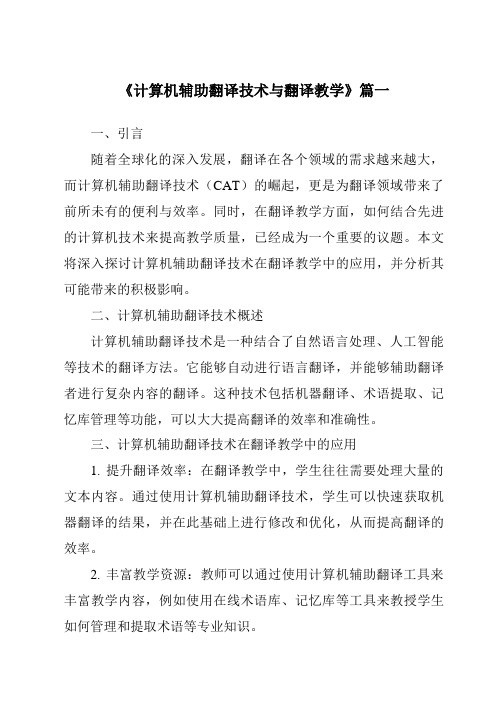
《计算机辅助翻译技术与翻译教学》篇一一、引言随着全球化的深入发展,翻译在各个领域的需求越来越大,而计算机辅助翻译技术(CAT)的崛起,更是为翻译领域带来了前所未有的便利与效率。
同时,在翻译教学方面,如何结合先进的计算机技术来提高教学质量,已经成为一个重要的议题。
本文将深入探讨计算机辅助翻译技术在翻译教学中的应用,并分析其可能带来的积极影响。
二、计算机辅助翻译技术概述计算机辅助翻译技术是一种结合了自然语言处理、人工智能等技术的翻译方法。
它能够自动进行语言翻译,并能够辅助翻译者进行复杂内容的翻译。
这种技术包括机器翻译、术语提取、记忆库管理等功能,可以大大提高翻译的效率和准确性。
三、计算机辅助翻译技术在翻译教学中的应用1. 提升翻译效率:在翻译教学中,学生往往需要处理大量的文本内容。
通过使用计算机辅助翻译技术,学生可以快速获取机器翻译的结果,并在此基础上进行修改和优化,从而提高翻译的效率。
2. 丰富教学资源:教师可以通过使用计算机辅助翻译工具来丰富教学内容,例如使用在线术语库、记忆库等工具来教授学生如何管理和提取术语等专业知识。
3. 促进理论与实践结合:通过结合具体的项目实践,学生可以运用计算机辅助翻译技术来处理真实的翻译任务。
这样不仅能够培养学生的实践能力,还能够让他们在实际操作中更好地理解和掌握理论知识。
四、计算机辅助翻译技术在翻译教学中的积极作用1. 提高学生的自主学习能力:计算机辅助翻译技术可以帮助学生自主学习和掌握翻译技能。
学生可以通过使用各种在线资源和工具来自我学习和提升,从而培养自己的自主学习能力。
2. 优化教学方法:教师可以根据学生的实际情况和需求,灵活运用计算机辅助翻译技术来优化教学方法。
例如,教师可以利用机器翻译的结果来帮助学生理解原文含义,再引导学生进行人工修改和优化。
3. 培养高素质的翻译人才:通过将计算机辅助翻译技术应用于教学中,可以培养出更多具备专业知识、技术技能和跨文化交际能力的优秀翻译人才,满足社会的需求。
《2024年计算机辅助翻译技术与翻译教学》范文

《计算机辅助翻译技术与翻译教学》篇一一、引言随着全球化的加速和科技的飞速发展,计算机辅助翻译技术(CAT技术)在翻译领域的应用越来越广泛。
与此同时,翻译教学也面临着新的挑战和机遇。
本文旨在探讨计算机辅助翻译技术在翻译教学中的应用,以及如何利用这一技术提升翻译教学的质量。
二、计算机辅助翻译技术的概述计算机辅助翻译技术,是指借助计算机软硬件资源,对人类语言间的自动翻译进行辅助的技术。
这一技术涵盖了自然语言处理、机器学习、人工智能等多个领域的技术手段。
CAT技术能够提高翻译效率,减少人工翻译的错误率,为翻译工作提供了极大的便利。
三、计算机辅助翻译技术在翻译教学中的应用1. 教学内容的丰富:计算机辅助翻译技术为翻译教学提供了丰富的资源,教师可以通过实际操作展示CAT技术的运用,让学生了解最新的翻译工具和技术。
2. 教学方法的革新:利用CAT技术,教师可以引导学生进行大量的翻译实践,提高学生的实际操作能力。
同时,教师还可以通过机器评估学生的翻译作品,帮助学生及时纠正错误。
3. 教学评估的改进:CAT技术能够快速生成统计数据,为教师提供学生的翻译进度、错误类型等数据,有助于教师及时调整教学策略,优化教学效果。
四、提升计算机辅助翻译教学质量的策略1. 加强师资培训:教师是教学活动的核心,应加强教师对CAT技术的培训,提高教师的技术应用能力和教学水平。
2. 强化实践教学:在翻译教学中,应注重实践教学,让学生通过实际操作掌握CAT技术,提高翻译能力。
3. 结合传统教学与现代技术:在利用CAT技术的同时,也要注重传统教学方法的运用,如讲解、讨论等,以提高学生的理论水平。
4. 关注学生个体差异:教师应关注学生的个体差异,根据学生的实际情况调整教学策略,确保每个学生都能在CAT技术的帮助下取得进步。
五、结论计算机辅助翻译技术在翻译教学中具有重要地位。
通过将这一技术引入课堂,教师可以丰富教学内容,革新教学方法,改进教学评估。
计算机辅助英语实践报告

计算机辅助英语实践报告Computer-assisted English practice is an essential tool for language learners, providing a wide range of benefits and opportunities to improve language skills. One of the most significant advantages of using computer-assisted English practice is the opportunity for self-paced learning. Learners can access materials and exercises at their convenience, allowing them to study and practice English at their own pace. This flexibility is particularly beneficial for individuals with busy schedules or those who may not have access to traditional classroom settings. Additionally, computer-assisted English practice often provides instant feedback, allowing learners to identify and correct errorsin real-time.Furthermore, computer-assisted English practice offersa variety of interactive and engaging activities that cater to different learning styles. These activities may include multimedia resources, interactive games, and virtual simulations, which can make the learning process moreenjoyable and effective. For example, language learners can engage in virtual conversations, listen to audio recordings, and participate in interactive exercises that reinforce vocabulary, grammar, and pronunciation skills. These interactive elements not only enhance engagement but also contribute to a more immersive language learning experience.In addition to self-paced learning and interactive activities, computer-assisted English practice also facilitates personalized learning experiences. Through the use of technology, learners can access customized learning materials and resources that align with their specific language proficiency levels, learning objectives, and interests. This personalized approach allows individuals to focus on areas of improvement and tailor their learning experiences to meet their unique needs. Moreover, computer-assisted English practice can track learners' progress and performance, providing valuable insights for both learners and educators to adjust and optimize the learning process.Another significant benefit of computer-assistedEnglish practice is the accessibility of authentic languageresources. With the use of technology, language learners can access a wealth of authentic materials, such as articles, videos, podcasts, and social media platforms, to immerse themselves in real-life language usage. This exposure to authentic language content can help learners develop their listening, reading, and comprehension skills, as well as gain insights into cultural nuances andlinguistic diversity. Furthermore, the accessibility of authentic resources through computer-assisted English practice can contribute to the development of learners' critical thinking and analytical skills as they engage with real-world language materials.Moreover, computer-assisted English practice can foster collaborative learning and communication among language learners. Through online platforms, learners have the opportunity to interact with peers, language tutors, and native speakers, regardless of geographical boundaries. This collaborative environment can promote language exchange, cultural exchange, and peer support, creating a sense of community and motivation for language learners. Additionally, collaborative learning through computer-assisted English practice can encourage learners topractice language skills in authentic communicative contexts, such as group discussions, collaborative projects, and peer feedback, which are essential for language development.In conclusion, computer-assisted English practiceoffers a multitude of benefits for language learners, including self-paced learning, interactive activities, personalized experiences, authentic resources, and collaborative opportunities. By leveraging technology, individuals can enhance their language skills, gaincultural insights, and connect with a global community of language learners. As technology continues to advance, the potential for computer-assisted English practice to further support language acquisition and proficiency is vast, making it an indispensable tool for language learnersaround the world.。
计算机辅助翻译实训报告格式

南昌工程学院《计算机辅助翻译实训》报告题目语言技能训练课程名称计算机辅助翻译实训系院外国语学院专业翻译班级2014级一班学生姓名孙力杰学号2014100332实习地点南昌工程学院校内指导教师肖永贺、邹斯彧实习起止时间:2015年12月7日至2015年12月13日目录一、实习时间ﻩ1二、实习地点...................................................... 1三、实习目得 (1)四、实习情况简介 (1)五、实习内容 (1)六、实习小结或体会 (2)七、部门主管3ﻩ八、参考文献 (4)九、指导教师评阅4ﻩ一、实习时间实训开始于2015年12月7日截止于2015年12月13日。
二、实习地点实习地点分为校内与校外两部分:校内实习地点就是教育技术楼A304教室(翻译工作坊)、A302教室(会议室);校外得实习地点就是南昌市八大山人纪念馆旅游景区。
三、实习目得1.掌握,熟悉目前市面上比较普遍得计算机辅助翻译软件以及了解其基本情况;2.在实践中,通过进行与计算机辅助翻译相关得活动以及翻译任务,使学生进一步了解计算机翻译得基本操作与原理。
熟悉翻译软件得使用,学习将来作为翻译人员所必需得基本得计算机辅助翻译工具操作技能;3.在模拟实战得训练中,让学生对自己得翻译水平有清晰得认识,从而提高学生在实际翻译工作中所需要利用各种计算机翻译软件进行翻译得能力。
四、实习情况简介在我们学校外国语学院得组织下,我们班计划在为期一周得时间(2015年12月7日至2015年12月13日)内,展开计算机辅助翻译实践活动》在这段期间,学院在教育技术楼提供了两个教室A304教室及A302教室,便于我们进行了综合技能实训。
一个就是翻译工作坊,就是我们翻译工作所需要得教室,另一个就是会议室,用于大家交流翻译过程中遇到得困难与收获得体会。
实训工作内容为学习利用计算机进行辅助翻译,熟悉目前市场上比较通用得计算机辅助翻译软件,掌握供成为现代译员所需得基本计算机辅助翻译工具操作技能。
计算机辅助翻译实训报告格式
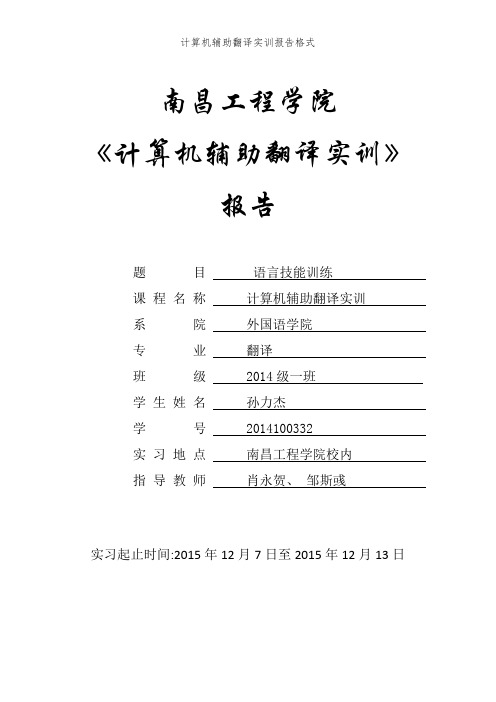
南昌工程学院《计算机辅助翻译实训》报告题目语言技能训练课程名称计算机辅助翻译实训系院外国语学院专业翻译班级 2014级一班学生姓名孙力杰学号 2014100332实习地点南昌工程学院校内指导教师肖永贺、邹斯彧实习起止时间:2015年12月7日至2015年12月13日目录一、实习时间 (1)二、实习地点 (1)三、实习目的 (1)四、实习情况简介 (1)五、实习内容 (1)六、实习小结或体会 (2)七、部门主管 (3)八、参考文献 (4)九、指导教师评阅 (4)一、实习时间实训开始于2015年12月7日截止于2015年12月13日。
二、实习地点实习地点分为校内与校外两部分:校内实习地点就是教育技术楼A304教室(翻译工作坊)、A302教室(会议室);校外的实习地点就是南昌市八大山人纪念馆旅游景区。
三、实习目的1.掌握,熟悉目前市面上比较普遍的计算机辅助翻译软件以及了解其基本情况 ;2.在实践中,通过进行与计算机辅助翻译相关的活动以及翻译任务,使学生进一步了解计算机翻译的基本操作与原理。
熟悉翻译软件的使用,学习将来作为翻译人员所必需的基本的计算机辅助翻译工具操作技能;3.在模拟实战的训练中,让学生对自己的翻译水平有清晰的认识,从而提高学生在实际翻译工作中所需要利用各种计算机翻译软件进行翻译的能力。
四、实习情况简介在我们学校外国语学院的组织下,我们班计划在为期一周的时间(2015年12月7日至2015年12月13日)内,展开计算机辅助翻译实践活动》在这段期间,学院在教育技术楼提供了两个教室A304教室及A302教室,便于我们进行了综合技能实训。
一个就是翻译工作坊,就是我们翻译工作所需要的教室,另一个就是会议室,用于大家交流翻译过程中遇到的困难与收获的体会。
实训工作内容为学习利用计算机进行辅助翻译,熟悉目前市场上比较通用的计算机辅助翻译软件,掌握供成为现代译员所需的基本计算机辅助翻译工具操作技能。
并且班级要分成若干个小组,以小组为单位,翻译5000字以上的材料,材料的内容为江西省内高校门户网站上的校园介绍信息。
计算机辅助翻译下的日汉翻译实践报告

计算机辅助翻译下的日汉翻译实践报告作者:曹雯来源:《世界家苑》2018年第12期摘要:在信息科技化发展的现代,辅助翻译的工具也日趋多元化。
笔者所接触的计算机辅助翻译工具大致可以分为在线计算机辅助翻译及计算机辅助翻译软件两种,并主要通过计算机辅助软件——trados的学习,进一步了解辅助翻译的相关知识。
计算机辅助翻译与以往的机翻不同,需要人工的参与以完成翻译任务。
通过Trados术语库及记忆库的运用,可以大幅度提高翻译的质量与速度。
Trados虽然适用于多种语言的翻译工作,但在对不同语言的翻译工作中产生的影响不同,过程中产生的问题也不同。
本文将通过计算机辅助翻译工具与日汉互译实践相结合,总结过程中遇到的问题以及计算机辅助翻译工具对笔译实践的积极作用。
关键词:计算机辅助翻译;术语库;记忆库1.计算机辅助翻译与翻译实践计算机辅助翻译的核心在于它的翻译记忆以及术语库,这两项技术的灵活掌握可以为翻译工作节省很多时间与精力,并大幅提高翻译的质量与准确性。
通常,在传统的翻译实践工作中,大多译者会选择纸质词典、电子词典或线上主流词典主要翻译辅助工具。
然而人的记忆能力有限,当翻译篇幅较长的文章时,即便之前翻译过的部分词汇或句子都会产生无法准确拿捏意义的情况,一般遇到这种情况时,通常都会选择再次查询词典等方法来重新翻译该部分,因此有可能造成前后矛盾或者不统一的问题。
而计算机辅助翻译的记忆库及术语库则能为此提供更加有效的翻译办法。
1.1 术语库对翻译实践的作用日汉互译中,经常会出现一词多义的情况,然而最终定夺的词义往往都不是字典上所给予的本义,而是选择该词语在本义基础上结合语境与上下文而派生出的衍生意义,尤以文学作品为甚。
本文的意义在于观察计算机辅助翻译软件在翻译工作中所产生的作用,加之笔者对辅助翻译技术仍处于入门阶段,因此笔者选择句法词义更为有规律的科技文章作为翻译文本,希望能在以后的计算机辅助翻译实践中提供更多的经验。
trados计算机辅助翻译实践报告
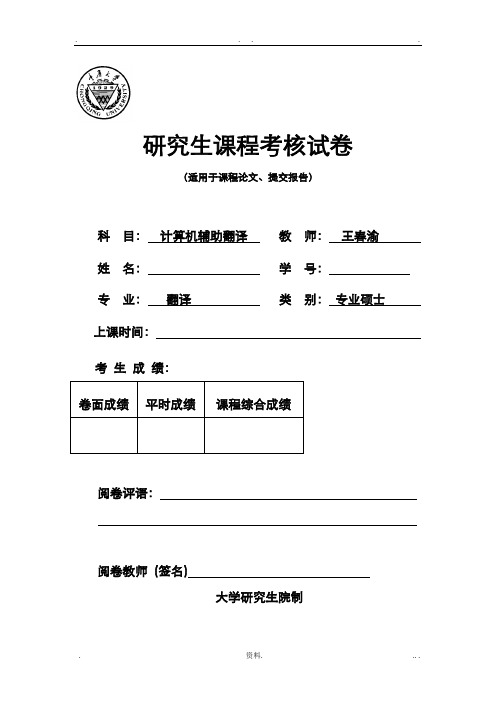
研究生课程考核试卷(适用于课程论文、提交报告)科目:计算机辅助翻译教师:王春渝姓名:学号:专业:翻译类别:专业硕士上课时间:考生成绩:卷面成绩平时成绩课程综合成绩阅卷评语:阅卷教师(签名)大学研究生院制目录摘要 (2)1 翻译任务描述 (2)1.1翻译任务背景介绍 (2)1.2任务性质 (2)2翻译过程描述 (2)2.1译前准备 (2)2.2 Trados辅助翻译流程 (2)3 翻译案例分析 (2)3.1文本翻译难点、问题及解决策略 (2)3.2 Trados技术问题及解决方案 (2)4 翻译实践总结 (2)4.1 Trados软件应用评价 (2)4.2对今后学习工作的启发及展望 (2)5 参考文献 (2)6、附录 (2)TRADOS翻译软件在《大别山》翻译中的应用摘要:本次翻译项目利用trados软件对《大别山》进行汉英翻译,旨在通过具体翻译实践,简单介绍计算机辅助翻译软件的使用方法和流程,总结计算机辅助翻译的优势与弊端,总结翻译经验,实现规化翻译。
本翻译报告包括翻译任务描述、翻译过程、翻译案例分析、翻译实践总结四个部分。
1 翻译任务描述1.1翻译任务背景介绍与传统翻译教育重翻译的学术性和理论性研究不同,MTI强调学生的实践性、应用性和专业化特点,根本目标是要培养国家社会、经济、文化建设需要的高层次、应用型、专业性翻译人才。
所以,对于MTI专业的学生来说,最核心的任务就是通过各种翻译实践来提高自己的业务水平和素质。
本次翻译项目旨在利用trados软件来进行汉英翻译,通过翻译项目的实践,在其过程中总结翻译策略及技巧,总结计算机辅助翻译的优势与弊端,实现规化翻译。
这对任何一位MTI 学生来说,都是一个磨练、提升和成长的宝贵机会和重要环节。
1.2任务性质本次翻译对象为《大别山》,全篇共计3578汉字,全文对大别山风景区加以详细描述,其中涉及大别山命名由来、景区建设、气温气候等相关概况,将大别山的自然与人文景观以全新的图文形态丰富,生动的展示出来,在引导旅游的同时兼能感受艺术、体会文化。
《2024年计算机辅助翻译技术与翻译教学》范文

《计算机辅助翻译技术与翻译教学》篇一一、引言随着全球化进程的加速和信息技术的飞速发展,计算机辅助翻译技术逐渐成为翻译领域的一项重要工具。
同时,翻译教学也面临着前所未有的挑战和机遇。
本文旨在探讨计算机辅助翻译技术在翻译教学中的应用,以及如何利用这一技术提高翻译教学的质量。
二、计算机辅助翻译技术概述计算机辅助翻译技术(CAT)是一种利用计算机软件和工具进行翻译的技术。
这种技术可以大大提高翻译效率,降低翻译成本,并提高翻译的准确性。
计算机辅助翻译技术包括机器翻译、人工辅助翻译和多人协作翻译等。
其中,机器翻译利用人工智能技术对原文进行自动翻译;人工辅助翻译则利用软件为译员提供原文的语言学特征和语义上下文等,以提高翻译的质量。
三、计算机辅助翻译技术在翻译教学中的应用1. 提高教学质量:通过计算机辅助翻译工具的使用,教师可以将教学重点从复杂的文本理解转移到注重教学质量的培养上,包括培养学生识别专业术语、分析语境的能力等。
此外,这些工具还可以帮助学生积累大量的实践经验和掌握有效的翻译技巧。
2. 提升学生技能:计算机辅助翻译技术有助于学生掌握自动翻译和人工干预的平衡,以及多种工具的使用方法。
这不仅可以提高学生的翻译速度和准确性,还可以让他们更好地应对各种复杂的翻译任务。
3. 促进跨文化交流:计算机辅助翻译技术有助于学生了解不同语言和文化之间的差异,促进跨文化交流和传播。
这对于培养学生的国际视野和跨文化交际能力具有重要意义。
四、如何利用计算机辅助翻译技术提高翻译教学质量1. 整合教学资源:教师可以将计算机辅助翻译工具与课程内容紧密结合,充分利用这些工具提供的教学资源,如词汇库、句法分析等。
同时,教师还可以根据学生的实际情况和需求,选择合适的工具进行个性化教学。
2. 培养综合能力:除了提高学生的语言能力外,还应注重培养学生的其他能力,如信息获取能力、文化素养等。
这有助于学生在使用计算机辅助翻译技术时更好地理解原文背景和意图。
计算机与网络辅助英语学习实践报告
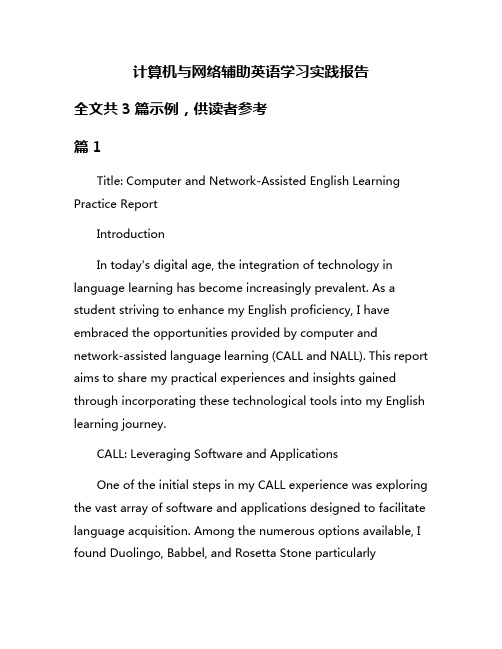
计算机与网络辅助英语学习实践报告全文共3篇示例,供读者参考篇1Title: Computer and Network-Assisted English Learning Practice ReportIntroductionIn today's digital age, the integration of technology in language learning has become increasingly prevalent. As a student striving to enhance my English proficiency, I have embraced the opportunities provided by computer and network-assisted language learning (CALL and NALL). This report aims to share my practical experiences and insights gained through incorporating these technological tools into my English learning journey.CALL: Leveraging Software and ApplicationsOne of the initial steps in my CALL experience was exploring the vast array of software and applications designed to facilitate language acquisition. Among the numerous options available, I found Duolingo, Babbel, and Rosetta Stone particularlybeneficial for building a solid foundation in English grammar, vocabulary, and pronunciation.Duolingo's gamified approach, with its bite-sized lessons and engaging exercises, made language learning feel like a captivating game rather than a tedious chore. The app's customizable daily goals and streak tracker motivated me to maintain consistency in my studies, while the leaderboard feature added a competitive element, further fueling my drive to progress.Babbel, on the other hand, impressed me with its comprehensive and structured curriculum. The app's lessons were meticulously designed to cater to different proficiency levels, ensuring a seamless learning curve. Additionally, the speech recognition technology provided invaluable feedback on my pronunciation, enabling me to identify and correct common errors.Rosetta Stone's immersive approach, which emphasized learning through context and visual cues, resonated with my preferred learning style. The app's interactive lessons simulated real-life scenarios, allowing me to practice conversational English in a risk-free environment, boosting my confidence in speaking the language.While these applications primarily focused on individual learning, I also explored collaborative platforms like Tandem and Conversely. These apps connected me with language partners from around the world, facilitating authentic conversations and cultural exchanges. Engaging in real-time conversations not only improved my spoken English but also exposed me to diverse accents and idioms, enhancing my overall comprehension.NALL: Harnessing the Power of the InternetAlongside software applications, the vast resources available on the internet played a pivotal role in my English learning journey. Online dictionaries and thesauruses, such asMerriam-Webster and , became indispensable tools for expanding my vocabulary and understanding nuances in word usage.Additionally, I discovered a wealth of educational content on platforms like YouTube and Khan Academy. From grammar lessons to pronunciation guides and interactive exercises, these resources provided a multimedia learning experience, catering to different learning styles and preferences.One particularly valuable resource was language learning blogs and forums, where I could connect with fellow learners, seek advice, and share experiences. These online communitiesnot only provided a supportive environment but also exposed me to diverse perspectives and strategies, enriching my overall learning experience.Furthermore, I leveraged online news outlets, podcasts, and audiobooks to immerse myself in authentic English content. By actively listening and reading materials on topics of interest, I could contextualize language usage and enhance my comprehension skills while staying engaged and motivated.Challenges and StrategiesWhile the integration of technology undoubtedly facilitated my English learning process, I encountered several challenges along the way. One of the primary obstacles was the abundance of resources available, which could sometimes lead to overwhelming choices and potential distractions.To address this challenge, I developed a structured plan and prioritized resources based on their effectiveness and alignment with my specific learning goals. Additionally, I implemented time management strategies, such as setting dedicated study sessions and limiting distractions during those periods.Another hurdle I faced was the lack of immediate feedback and personalized guidance, which is often present in traditionalclassroom settings. To mitigate this, I sought out online tutors and joined virtual language exchange programs, where I could receive personalized feedback and engage in real-time conversations with native speakers or experienced language learners.ConclusionMy journey through computer and network-assisted English learning has been a transformative experience. The integration of technology has not only enhanced my language proficiency but has also fostered a love for lifelong learning and a deeper appreciation for cultural diversity.As I reflect on my experiences, I am convinced that the effective use of CALL and NALL resources can significantly accelerate language acquisition and provide a more engaging and personalized learning experience. However, it is crucial to approach these tools with a structured plan, a growth mindset, and a willingness to adapt and experiment with different strategies.Looking ahead, I am excited to continue exploring the ever-evolving landscape of technology in language learning, embracing new innovations and methodologies that can furtherenrich my journey towards fluency in English and potentially other languages.篇2Title: Computer and Network Assisted English Learning Practice ReportIntroductionAs a college student in the 21st century, technology has become an integral part of our daily lives, and its application in the field of education is no exception. In this practice report, I will share my experiences and insights regarding the use of computers and networks in assisting my English language learning process.Body ParagraphsOnline Learning Platforms and ResourcesOne of the most significant advantages of computer and network assisted English learning is the vast array of online learning platforms and resources available. Platforms such as Coursera, edX, and Duolingo offer a wide range of English courses, from beginner to advanced levels, taught by experienced instructors from prestigious universities andinstitutions around the world. These platforms provide interactive lessons, quizzes, and exercises that cater to different learning styles and allow for self-paced learning.Furthermore, the internet is a treasure trove of English learning materials, including websites, blogs, podcasts, and YouTube channels. These resources cover various topics, from grammar and vocabulary to pronunciation and listening comprehension. By immersing myself in these authentic English materials, I have been able to improve my language skills while also gaining insights into different cultures and perspectives.Virtual Classrooms and Online TutoringIn addition to self-study resources, computer and network technologies have facilitated virtual classrooms and online tutoring services. During the COVID-19 pandemic, when traditional classroom settings were disrupted, these virtual platforms became invaluable for continuing my English education. Through video conferencing tools like Zoom or Skype, I could attend live classes, participate in group discussions, and receive personalized feedback from instructors and tutors.One particular advantage of virtual classrooms is the ability to connect with English learners and native speakers from around the globe. This exposure to diverse accents, idioms, andcultural references has broadened my understanding of the English language and its nuances.Language Learning Apps and SoftwareMobile applications and software designed specifically for language learning have also played a significant role in my English studies. Apps like Duolingo, Babbel, and Rosetta Stone offer gamified lessons, spaced repetition techniques, and personalized study plans, making the learning process engaging and enjoyable.These apps often incorporate features such as speech recognition, which allows me to practice my pronunciation and receive instant feedback. Additionally, many of these apps sync across devices, enabling seamless learning on-the-go, whether I'm commuting or waiting in line.Online Writing and Feedback ToolsAs a student, developing strong writing skills is crucial, and computer and network technologies have provided invaluable tools in this area. Online writing platforms like Grammarly and Hemingway App offer real-time feedback on grammar, spelling, and style, helping me to identify and correct errors in my writing.Moreover, peer-review and collaborative writing tools, such as Google Docs, have facilitated the process of receiving feedback from classmates and instructors. By sharing my work online and receiving comments and suggestions, I have been able to improve my writing skills more efficiently.Social Media and Language ExchangeSocial media platforms have also played a role in my English learning journey. By following and interacting with English speakers on platforms like Twitter, Instagram, and Reddit, I have been exposed to authentic language usage and cultural references. Additionally, language exchange apps like Tandem and Hellotalk have connected me with native English speakers from around the world, providing opportunities for real-time conversation practice and cultural exchange.Challenges and LimitationsWhile computer and network assisted English learning offers numerous advantages, it is important to acknowledge some of the challenges and limitations associated with this approach.One potential issue is the risk of over-reliance on technology, which can lead to a lack of face-to-face interaction and development of interpersonal communication skills. Additionally,the quality of online resources can vary greatly, and it is essential to evaluate the credibility and accuracy of the information obtained.Furthermore, access to technology and reliable internet connections can be a barrier for some learners, particularly in areas with limited infrastructure or resources.ConclusionIn conclusion, computer and network assisted English learning has revolutionized the way I approach language acquisition. The wealth of online resources, virtual classrooms, language learning apps, and social media platforms have provided me with a diverse and engaging learning experience.However, it is crucial to strike a balance between technology-assisted learning and traditional methods, as well as develop critical thinking skills to navigate the vast online landscape effectively. By embracing the advantages of computer and network assisted English learning while being mindful of its limitations, I believe I can continue to enhance my language proficiency and broaden my cultural horizons.篇3Computer and Network-Assisted English Learning Practice ReportIntroductionIn today's globalized world, proficiency in the English language has become an invaluable asset, opening doors to countless opportunities across diverse fields. As a student, I have embarked on a journey to enhance my English skills through the integration of technology into my learning process. This practice report delves into my experiences with computer andnetwork-assisted English learning, exploring the various tools, resources, and techniques that have proven instrumental in my language acquisition endeavors.The Role of Technology in Language LearningThe advent of technology has revolutionized the way we approach language learning. Traditional methods, while still valuable, can be supplemented and enriched by the vast array of digital resources at our disposal. From online dictionaries and grammar guides to interactive language-learning platforms and virtual classrooms, the possibilities for immersive and engaging English learning experiences are truly remarkable.Online Resources and PlatformsOne of the most significant advantages of computer and network-assisted English learning is the accessibility to a wealth of online resources. Websites such as Duolingo, Babbel, and Rosetta Stone offer comprehensive language courses tailored to different proficiency levels and learning styles. These platforms employ gamification techniques, making the learning process enjoyable and engaging, while simultaneously reinforcing vocabulary, grammar, and pronunciation through interactive exercises and real-world scenarios.Furthermore, online dictionaries and translation tools like Google Translate and WordReference have proven invaluable in my language learning journey. These resources not only provide accurate translations but also offer insights into contextual usage, idioms, and colloquialisms, enhancing my understanding of the nuances of the English language.Multimedia and Authentic MaterialsAnother significant advantage of computer andnetwork-assisted English learning is the abundance of multimedia resources and authentic materials readily available online. Podcasts, audiobooks, and online radio stations provide opportunities for immersive listening practice, exposing me to different accents, speech patterns, and cultural contexts.Similarly, online newspapers, magazines, and blogs offer a wealth of reading materials on diverse topics, allowing me to expand my vocabulary and comprehension skills while staying informed about current events and trends.Moreover, video-sharing platforms like YouTube and Vimeo host an extensive collection of educational content, including language lessons, instructional videos, and vlogs created by native English speakers. These resources not only enhance my listening and comprehension abilities but also provide valuable insights into cultural nuances and body language, further enriching my understanding of the English language.Virtual Classrooms and Language ExchangeThe integration of technology has also facilitated virtual classrooms and language exchange platforms, enablingreal-time interaction and collaboration with fellow learners and native speakers from around the globe. Applications such as Zoom, Skype, and Google Meet have allowed me to participate in online language classes, group discussions, and one-on-one conversation sessions, providing invaluable opportunities to practice speaking and receive immediate feedback from experienced instructors and language partners.Additionally, language exchange websites and apps like Conversely and Tandem have connected me with native English speakers who are also learning my native language. This mutually beneficial exchange has not only improved my English proficiency but has also fostered cross-cultural understanding and lasting friendships.Personalized Learning and Progress TrackingOne of the most significant advantages of computer and network-assisted English learning is the ability to personalize the learning experience. Many language-learning platforms and apps offer personalized learning paths based on individual strengths, weaknesses, and goals. Through adaptive algorithms and AI-powered technologies, these platforms tailor the content and pace of learning to my specific needs, ensuring efficient and effective language acquisition.Furthermore, these digital tools often incorporate progress tracking features, allowing me to monitor my achievements, identify areas for improvement, and set realistic goals for continued growth. This data-driven approach has been instrumental in maintaining motivation and measuring my progress over time.Challenges and LimitationsWhile computer and network-assisted English learning offers numerous advantages, it is essential to acknowledge and address potential challenges and limitations. One concern is the risk of over-reliance on technology, which may hinder the development of interpersonal communication skills andface-to-face interaction abilities. Additionally, the abundance of online resources can be overwhelming, and it is crucial to exercise discernment in selecting high-quality and reputable materials.Furthermore, technical issues such as poor internet connectivity or compatibility issues with certain devices or software can disrupt the learning process. It is essential to have contingency plans and alternative learning methods in place to mitigate these potential disruptions.ConclusionIn conclusion, computer and network-assisted English learning has been an invaluable component of my language acquisition journey. The integration of technology has opened up a world of opportunities, providing access to a vast array of resources, interactive platforms, and immersive experiences. From online courses and multimedia materials to virtual classrooms and language exchange programs, these digital toolshave not only enhanced my English proficiency but have also fostered cultural awareness and global connections.However, it is important to strike a balance between technology-assisted learning and traditional methods, recognizing the value of human interaction and face-to-face communication. By embracing a blended approach that combines the best of both worlds, students can maximize their language learning potential and develop well-rounded communication skills.As I continue on my journey of English language acquisition, I remain committed to leveraging the power of technology while maintaining a holistic and balanced approach. The skills and experiences gained through computer and network-assisted English learning will undoubtedly serve as valuable assets in my academic pursuits, future career endeavors, and personal growth.。
计算机辅助翻译英语作文

计算机辅助翻译英语作文1️⃣ 篇一:计算机辅助翻译,我的英语考试救星?嘿,小伙伴们,今天咱们来聊聊那个让人又爱又恨的计算机辅助翻译(CAT)工具吧!在备考英语资格考试的那些日子里,它简直就是我的秘密武器,也可能说是我的“小确幸”。
记得第一次接触CAT工具时,心里那叫一个忐忑啊,毕竟习惯了传统翻译方式的我,对这高科技玩意儿还真有点不适应。
但当我试着用它来翻译一篇关于环保的范文时,哇塞,效率直接翻倍!那些繁琐的词汇、复杂的句式,在CAT的帮助下,瞬间变得井井有条。
不过,话说回来,CAT也不是万能的。
有时候,它翻译出来的句子虽然语法正确,但总觉得少了点“灵魂”。
就像一道菜,虽然食材齐全,但少了厨师的精心调味,总觉得差点意思。
所以,我在使用CAT时,总是习惯性地加入一些自己的理解和表达,让译文更加地道、生动。
就这样,我和CAT成了备考路上的好伙伴。
每当遇到难题,我都会先自己琢磨一番,然后再借助CAT的力量,找到最佳的解决方案。
虽然过程中也免不了有些小插曲,比如偶尔的误译、漏译,但正是这些不完美,让我的学习过程充满了挑战和乐趣。
2️⃣ 篇二:CAT工具,是作弊还是助力?聊到计算机辅助翻译,总免不了有人质疑它的正当性。
毕竟,在严格的资格考试中,使用任何形式的辅助工具都可能被视为作弊。
但在我看来,CAT工具更像是一位默默无闻的助手,而非作弊的帮凶。
想象一下,当你面对一篇长达数千字的英文文章,需要快速准确地翻译成中文时,那种压力山大的感觉。
如果没有CAT工具的帮助,恐怕很多人都会感到力不从心。
而CAT工具的出现,正是为了解决这一难题,它能够帮助我们快速提取关键信息,提高翻译效率。
当然,这并不意味着我们可以完全依赖CAT工具。
毕竟,翻译是一门艺术,需要译者具备深厚的语言功底和丰富的文化背景知识。
CAT工具只能作为辅助手段,帮助我们更好地完成翻译任务。
因此,在使用CAT工具时,我们应该保持清醒的头脑,明确自己的定位和责任。
- 1、下载文档前请自行甄别文档内容的完整性,平台不提供额外的编辑、内容补充、找答案等附加服务。
- 2、"仅部分预览"的文档,不可在线预览部分如存在完整性等问题,可反馈申请退款(可完整预览的文档不适用该条件!)。
- 3、如文档侵犯您的权益,请联系客服反馈,我们会尽快为您处理(人工客服工作时间:9:00-18:30)。
计算机辅助翻译
实践报告
Academy: School of foreign language and literature Name: 梁嘉欣(组长)霍罗娜陈兵杨忠谕杨志平
Class: __________________ Class 13, 2013 _______________________
Supervisor:
PPT 翻译
一、操作过程
1.创建翻译记忆库
Mr. Wang
2.导入PPT至TagEditor
■HR B ir
■M*
阵f・i:»u 屮
Et
■
■ *w
• K£k忡.i冲
:异” |# b>tiM-i■!-*■>-.
■ it vJr tM
m -片Tiwia^iMiTBiR-G-
»在这种场合陌生人相识
t
如果是亚洲人,他门往往开口之前先毕恭 毕敬
地用双手把自已的名片呈递给対方,这好像是不可缺少的礼节° When meet ing <L st j'Einx^r 〔HI ^uch nceasion, an Asian tends to present his or hpr card before a convprsation is started T which seems to be an indispensable courtesy. ”
-fatal
亘
菇然而,法国人一般却都不大主动递送名片。
L ——严 一——… 1 工 丄 一 ■ ____________________________________________________________________________________________________ nna
SB
3.翻译文档
覚■吕. 护" LJ K« «■ MBS. F.疾 3 叱
■■■ba Art Fl Ml iJMa* * ・v
4.另存译文
-:l r” ■■£;?M| WMn* Ujr iMir mH
汀J•」I - - ' ■** 打rm ■
I ________________ * 2'
Mir I 4 ■ | f | C I - l •■」■. d 蛰-
机
Wt如
轲生人相识,如果量亚洲人
t
他们往往开口之前先毕恭牛厳电用煤十把自己的名片呈递给对有.这好像是不可缺少的礼节。
rfht?n inpet in^ Et st rHn^pf tjn suc'h nt ras i on, MII A>i i
l ^ntl^ f u
present his or her card before 烈conversation is
started ,wliicli seems to be ail intlispensable courtesy. j
4E)■-然而,法国人一般却都不大主动逹送名片?
仍“呻■■ CJ M X’EC wy U氏:
,■電■l s.awTmr i n・£覽1■■
5.检查译文PPT
■Mhti
OTlUrtKr.
ppflrni
i DmwLi
;^-rUWjmr
■■匚
6.对齐文档
■it 鬥■”・ F M
・-二血騷-J・
7.对齐成功
Jw、*■曲®
1・!!估||>V> fr^-ii
fl
*
* 1>S«M
8.导出文件对
9.导入翻译记忆库
10•导入成功
二、心得体会
1.P PT翻译时注意格式与原文保持一致。
2.出现“未将对象引用设置到对象的实例”的问题
解决:重新调整PPT格式,使之每页保持一致。
3.trados 07版本翻译记忆库可以导入文件对,与11版一致。
